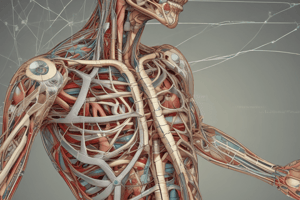Podcast
Questions and Answers
Which spinal nerve roots form the brachial plexus?
Which spinal nerve roots form the brachial plexus?
- C5-T1 (correct)
- T1-T4
- C3-C6
- C1-C4
The posterior rami of spinal nerves C5-T1 form the roots of the brachial plexus.
The posterior rami of spinal nerves C5-T1 form the roots of the brachial plexus.
False (B)
What anatomical landmark is used to name the cords of the brachial plexus?
What anatomical landmark is used to name the cords of the brachial plexus?
axillary artery
Erb's palsy typically involves injury to the upper roots of the brachial plexus, specifically nerves _____ and _____.
Erb's palsy typically involves injury to the upper roots of the brachial plexus, specifically nerves _____ and _____.
Match the following parts of the brachial plexus with their description:
Match the following parts of the brachial plexus with their description:
In Erb's palsy, which of the following is a characteristic position of the affected limb?
In Erb's palsy, which of the following is a characteristic position of the affected limb?
What spinal nerve roots are affected in Klumpke's palsy?
What spinal nerve roots are affected in Klumpke's palsy?
Klumpke's palsy is more common than Erb's palsy.
Klumpke's palsy is more common than Erb's palsy.
What is the primary feature of Klumpke's palsy in the hand?
What is the primary feature of Klumpke's palsy in the hand?
In upper limb dissection, an 'M' shape formed by which three nerves can help identify the brachial plexus?
In upper limb dissection, an 'M' shape formed by which three nerves can help identify the brachial plexus?
Flashcards
Brachial Plexus
Brachial Plexus
Network of nerve fibers supplying skin and musculature of the upper limb, originating from anterior rami of C5-T1 spinal nerves.
Roots of Brachial Plexus
Roots of Brachial Plexus
Anterior rami of spinal nerves C5, C6, C7, C8, and T1 that form the beginning of the brachial plexus.
Trunks of Brachial Plexus
Trunks of Brachial Plexus
Formed by the convergence of the roots (C5-T1) at the base of the neck; superior, middle, and inferior.
Divisions of Brachial Plexus
Divisions of Brachial Plexus
Signup and view all the flashcards
Cords of Brachial Plexus
Cords of Brachial Plexus
Signup and view all the flashcards
Major Branches of Brachial Plexus
Major Branches of Brachial Plexus
Signup and view all the flashcards
Erb's Palsy
Erb's Palsy
Signup and view all the flashcards
Klumpke's Palsy
Klumpke's Palsy
Signup and view all the flashcards
'M' Shape in Brachial Plexus
'M' Shape in Brachial Plexus
Signup and view all the flashcards
Study Notes
- The brachial plexus is a network of nerve fibers supplying the skin and musculature of the upper limb, starting in the root of the neck, passing through the axilla, and running through the entire upper extremity.
- The plexus is formed by the anterior rami of cervical spinal nerves C5, C6, C7, C8, and the first thoracic spinal nerve, T1.
- The brachial plexus is divided into five parts: roots, trunks, divisions, cords, and branches.
- The 'roots' refer to the anterior rami of the spinal nerves that comprise the brachial plexus, specifically C5, C6, C7, C8, and T1.
- Paired spinal nerves arise at each vertebral level, leaving the spinal cord via the intervertebral foramina, then dividing into anterior and posterior rami.
- The anterior rami of spinal nerves C5-T1 form the roots of the brachial plexus.
- These nerves pass between the anterior and medial scalene muscles to enter the base of the neck.
- At the base of the neck, the roots converge to form three trunks, named by their relative anatomical location.
- The trunks traverse laterally, crossing the posterior triangle of the neck.
- Each trunk divides into two branches (anterior and posterior divisions) within the posterior triangle of the neck.
- The divisions leave the posterior triangle and pass into the axilla.
- The anterior and posterior divisions recombine into the cords of the brachial plexus in the axilla.
- The three cords are named by their position relative to the axillary artery.
- The three cords give rise to five major branches in the axilla and proximal upper limb, which innervate the muscles and skin.
- The musculocutaneous, median, and ulnar nerves form an 'M' shape, which is a consistent landmark to identify parts of the brachial plexus during dissection.
- Smaller nerves also arise from all five parts of the brachial plexus.
Erb's Palsy
- Erb's palsy is an injury to the upper roots of the brachial plexus (typically C5-6), often from a stretching injury during difficult vaginal delivery.
- The affected limb hangs limply, medially rotated by the unopposed action of pectoralis major.
- The forearm is pronated due to loss of biceps brachii function.
- The wrist is weakly flexed, resulting in a "waiter's tip" position.
Klumpke's Palsy
- Klumpke's palsy is an injury of the lower roots of the brachial plexus (C8-T1), also associated with difficult vaginal delivery, but less common than Erb's palsy.
- The primary feature is a clawed hand due to paralysis of the lumbrical muscles.
- Paralysis of the lumbricals causes the fingers to become extended at the MCPJs and flexed at the IPJs.
Studying That Suits You
Use AI to generate personalized quizzes and flashcards to suit your learning preferences.




